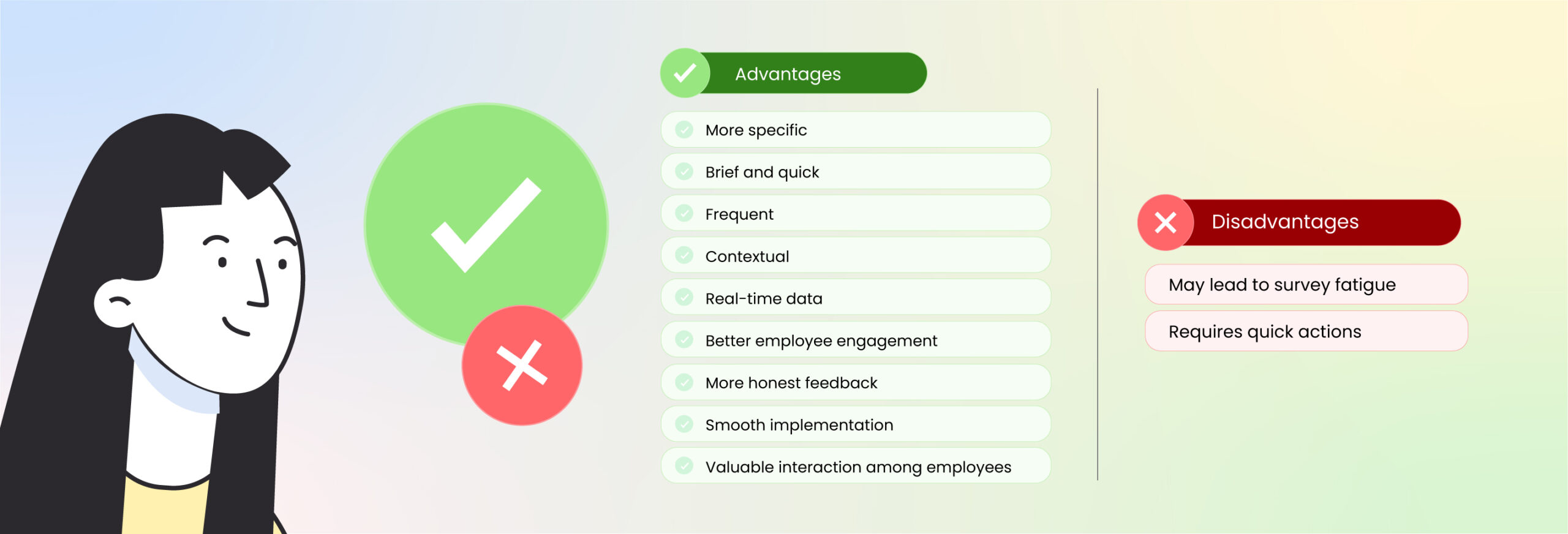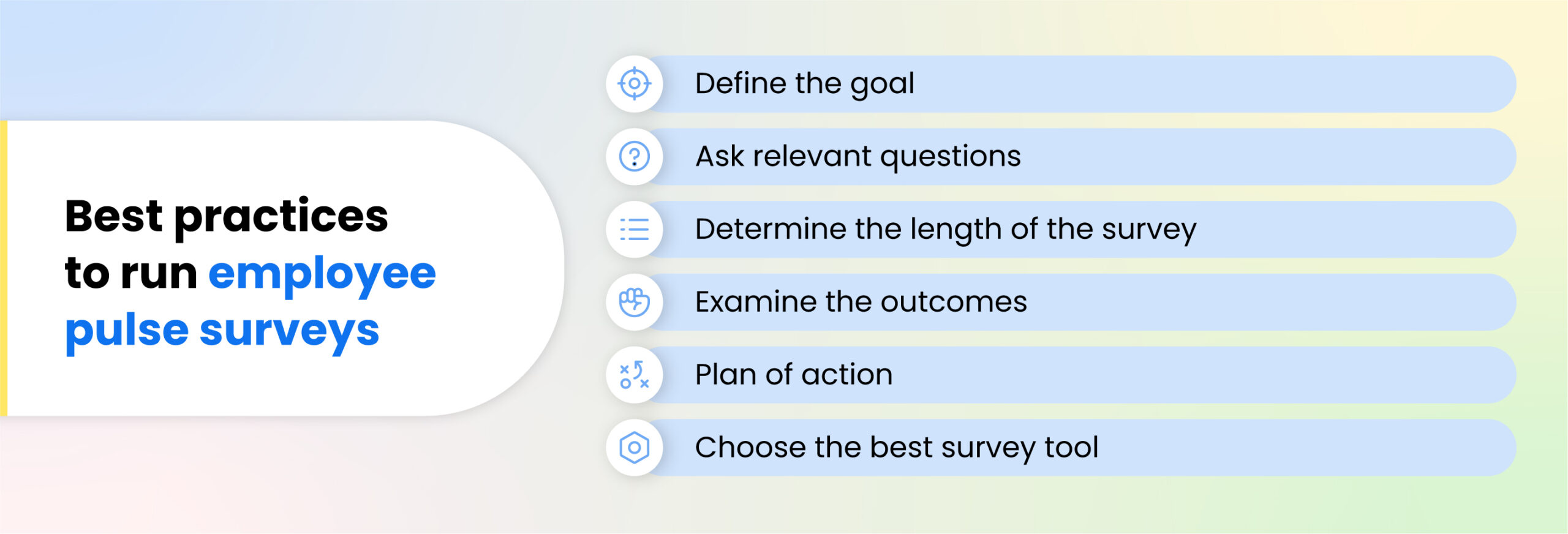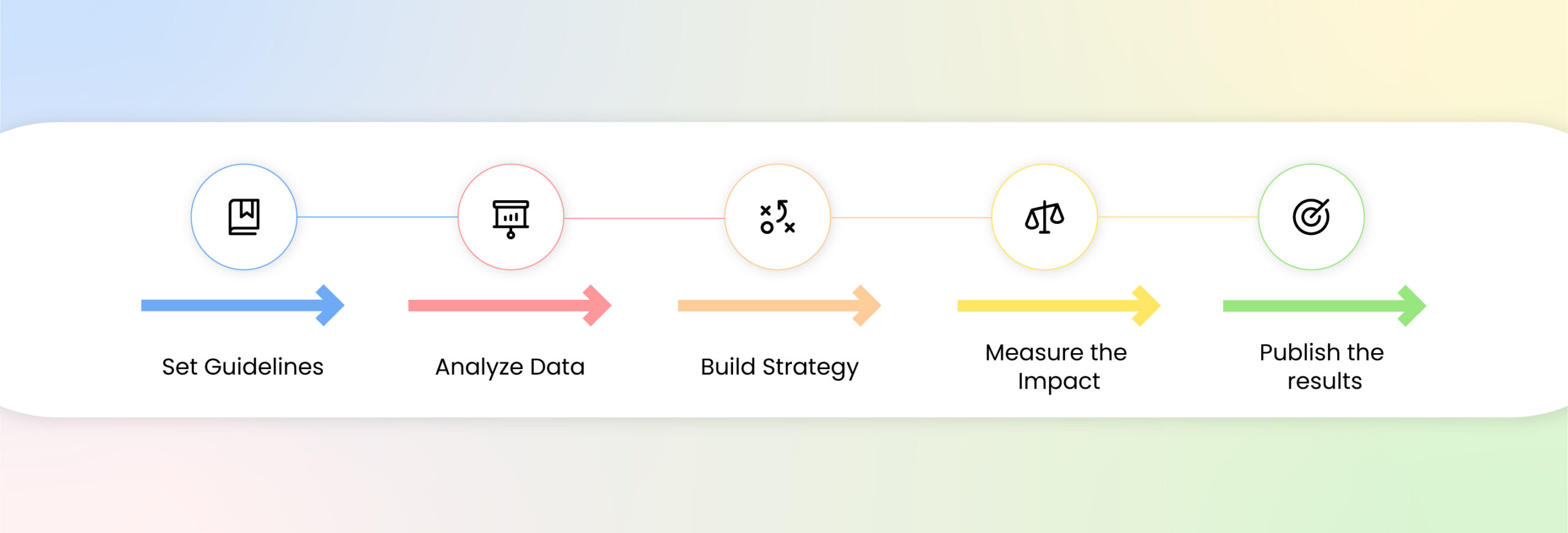Introduction To Employee Pulse Surveys
Employees are the pulse of your organization, and happy employees are your assets. A critical factor for a happy and engaged workforce is knowing the employees’ pulse. And, what better way to achieve it than through short and frequent feedback surveys, also known as employee pulse surveys.

Employee pulse surveys are efficient and quick, so they can be implemented seamlessly on a larger scale. These employee pulse check surveys take just a few minutes to complete but significantly help inform the business leaders and stakeholders about the issues of their employees.
With employee engagement pulse surveys, an organization can gather real-time feedback on engagement issues and take quick actions to solve them.
But what is a pulse survey exactly, and how do you structure it for the best possible results?
To help you with these answers, we will discuss the intricacies of employee pulse surveys, their best practices, how to structure the questions, and the best employee pulse survey software.
So without further ado, let’s dive right into it.
Employee Pulse Survey Definition
Employee pulse surveys are a review model strategically designed for quick and efficient collection of employee feedback. In simple terms, employee pulse surveys are brief feedback questions covering varied organizational themes such as manager, team, job, work culture, growth, etc. among others.
These brief surveys are simple to design and take minimal resources to circulate. Their structure makes them a better alternative to long and cumbersome yearly surveys.
Pulse surveys have short, straightforward questions that reflect the core issues employees are facing in the workplace. With quick and routine feedback gathered through employee pulse survey questions, organizations can take fast action and design strategic initiatives in the workplace.
What Do Employee Pulse Surveys Measure?
Pulse surveys for employees should be organized around topics that cover all of the important components that will yield the most detailed insights from employee responses. The structure for your employee engagement pulse surveys should ideally be constructed around the following key themes that cover the length and breadth of your organization:
 Leadership
Leadership
Does your workforce trust their management? Do they feel they can easily communicate with the leadership? It is important to gauge the relationship between employees and the management team. Open communication between employees and management contributes to a more loyal staff. This eventually leads to a more engaging work environment.
 Organization
Organization
How aligned the workforce is to the organizational goals and vision? Do they agree with the company’s policies? Do they feel discriminated against on any grounds? Are they happy with the work culture?
 Work
Work
It is critical to find out if your employees are satisfied with their job roles/work in this section. Is there a lot of work on their plates? Do they consider themselves to have a work-life balance? Do they enjoy what they do on a daily basis? Inputs on such questions will reveal any kind of need for improvement in the team or department.
 Satisfaction
Satisfaction
Feeling happy and satisfied with the organization, the manager, and the job role is what drives employee motivation. Therefore, learning the gaps here can make a lot of difference. Understanding what drives satisfaction or dissatisfaction at the workplace can help in building a more specific engagement strategy.
 Manager
Manager
How happy are your employees with their immediate supervisor/manager? Do they share a healthy work relationship or not? Does the team have a positive work environment? Employee feedback on such questions can help in identifying internal politics, any fights within the team, and any kind of bias.
 Growth
Growth
How your employees feel about their advancement in the organization can readily predict their attrition rate. Employees’ intentions to stay with the organization can be gauged by whether they feel efficient and capable of achieving their professional goals.
 Team
Team
Is there a sync between employees and their teams? Do the team members support each other? Building feedback around this theme would reveal whether there are any team-building activities required or in-person catch-ups that need to be conducted.
 Training and learning needs
Training and learning needs
Is there a desire among your employees to develop new skills? Do their current skills meet the industry standards necessary for the job? Are they interested in a new course that will help them become more efficient? Getting feedback on this theme can aid in the development of a learning and development strategy, which will lead to the formation of a more efficient workforce.
 Rewards and recognition
Rewards and recognition
Do your employees feel recognized by their immediate supervisor in terms of rewards and recognition? Do they feel valued and acknowledged at work for their accomplishments? Understanding these gaps will allow you to revisit your rewards and recognition plan and determine whether large-scale or small-scale R&R activities are required.
 Diversity, equity, and inclusion
Diversity, equity, and inclusion
Is there any gender or racial bias on the team? Do they believe they are fairly compensated for their skills and experience? Are the managers enthusiastic about DE&I strategies? Utilize the feedback to overcome unique challenges and begin making an instant effect.
 Mental well-being
Mental well-being
Is there an excessive strain on a particular team or a team member? Is your team satisfied with their work-life balance? Do they feel joyful when they go to work every day? Gathering information on these questions can help you identify your employees’ current mental health and predict attrition in the organization.
 Change management
Change management
Does your staff believe that the organization is there to support them during times of change and transition? Do they have a firm grasp on the organization’s growing goals, processes, and technologies? When employees don’t understand why changes are taking place, it can be difficult to drive ownership and commitment, and it can even lead to resistance or pushback.
The data and insights shared by employee engagement pulse surveys built around the above-listed themes assist organizations in accurately measuring engagement levels and employee happiness. Conducting frequent employee pulse surveys is absolutely essential for organizations to grow in a competitive business scenario.
Why Is An Employee Pulse Check Important?
Employee feedback pulse surveys offer in-depth employee sentiment insights to help you build a high-yielding employee engagement strategy. Conducting employee pulse surveys is the key to achieving higher employee participation for honest and real-time feedback.
Here’s why a regular employee pulse check is important:
- When an organization conducts frequent pulse checks of employees, the chances of missing granular but important information become minuscule.
- With data gathered in real-time, pulse surveys will assist you in addressing the action in the concerned areas on the go.
- Frequent check-ins via surveys give the employees confidence that their employer listens to them no matter how minor the issue is.
- With employee pulse surveys, addressing issues of specific departments becomes quick and manageable.
What Are The Advantages & Disadvantages of Employee Pulse Surveys?

Employee pulse surveys provide exceptional insights into the emotions, feelings, and state of mind of employees. Such comprehensive data has the potential to enhance the efficacy of your engagement strategy and produce effective results.
Advantages of Employee Pulse Surveys:
More specific
Annual surveys cover many issues, while pulse surveys target specific areas. Hence, feedback from such surveys helps organizations target particular problems and resolve them more efficiently.
Brief and quick
Employee pulse surveys allow you to get a whole picture of your employee’s perception of the organization. Moreover, employees are more likely to participate in a brief and pointed survey than a long and tiresome annual review form.
Frequent
Workplace pulse surveys are structured according to the individual organization’s needs, enabling them to conduct more frequently. Hence the organization can maintain a flow of actionable feedback and be consistent in addressing them.
Contextual
Since pulse surveys can be conducted frequently, the employer can detect what part of specific strategies work in which department and what does not. Such analysis, in turn, helps bring strategic and contextual change to the existing policies and results in better employee engagement and experience.
Real-time data
With annual employee surveys, capturing the granular data of employee feedback becomes difficult. Since employee pulse surveys are frequent, it becomes easier for the organization to gather real-time data on how your workers feel about your organization’s work culture. You can quickly know your employees’ recent and ongoing grievances with employee pulse surveys. This information also enables the employer to take quick action in no time.
Better employee engagement
Trends in the workplace show that frequent employee engagement pulse surveys are directly linked to better employee engagement. When the management periodically asks employees what they can do better, employees feel valued and put more effort into their jobs.
More honest feedback
Organizations traditionally depend on one-to-one manager and employee meetings for feedback. But did you know that anonymous employee pulse surveys are more likely to get honest feedback?
Whether pulse surveys should be anonymous or not has been the topic of much debate for a long time.
Here are the pros and cons of anonymous pulse surveys.
Pros:
- Anonymity encourages employees to be more candid and avoid beating around the bush.
- The majority of survey participants will not hesitate to respond due to the fact that they do not fear retribution or embarrassment.
- Respondents are more likely to discuss sensitive subjects and provide more comprehensive and transparent details.
Cons:
- Instead of focusing on the actual difficulties, the feedback might appear as an attack on a particular person, process, or the entire leadership team.
- Instead of following up with a specified set of persons, you may need to send out a second survey in an attempt to get the necessary data from anonymous respondents.
- In enterprises where individual responses are scrubbed of all identifying information, it might be challenging for HR and management to determine the pain areas and underlying causes of a negative response.
Overall, anonymous pulse surveys may undermine the activity’s purpose. To find a compromise, confidential pulse surveys may be an appropriate solution. The distinction between confidentiality and anonymity is crucial. With a confidential survey, replies are not made public, whereas with an anonymous survey, no one within the company, regardless of position, has access to the identities of respondents.
Smooth implementation
With digital technology, compiling and conducting frequent pulse surveys is not tricky. Since many organizations are adopting hybrid work structures, they can circulate employee pulse surveys remotely.
Disadvantages of Employee Pulse Surveys:
May lead to survey fatigue
Sending out lengthy employee pulse surveys too frequently can lead to employee survey fatigue. Employees will put less effort into surveys if asked too often. Each organization is different, so is the frequency of their employee pulse surveys. For some organizations, weekly pulse surveys with 5 questions works like a charm, for others the same could lead to survey fatigue. We suggest you start with a monthly pulse survey on a designated date, like the last Friday of every month and alter as you go!
Requires quick actions
Organizations need to find a sweet spot between feedback and action. If feedback doesn’t translate into actions and changes, employees will slowly lose interest and it will just become a pointless activity. Because employees are giving honest feedback, they also expect immediate action. If you ignore their feedback, they will not be willing to share feedback again. Therefore, do assess if you have the resources to convey and act on weekly feedback (which is the expectation you are setting).
Pulse Survey vs. Engagement Survey: How Are Pulse Surveys Different from Engagement Surveys?
|
Employee Pulse Surveys |
Employee Engagement Surveys |
|
Easy to complete, with at max 15 questions |
Consist of 25-50 questions |
|
Can be conducted weekly, monthly or on a quarterly basis, depending on themes covered |
Conducted on an annual or half-yearly basis |
|
Gauge employees’ sentiments regarding recent changes or announcements |
Measures employee’s view of the company |
|
More specific, timely, and brief data |
Complex to design and analyze the data |
How to Successfully Run Pulse Surveys?

Many businesses are moving away from extensive annual surveys and towards fast employee pulse polls. If you want to conduct employee engagement pulse surveys at your company, this is the place to be. Here are some employee pulse survey best practices that must be followed:
Define the goal
The first thing you must address is why you need to conduct pulse surveys. Before creating the questionnaire, brainstorm the areas you wish to measure. Then, decide the areas you would like to focus on in this survey. Make sure to include people from various parts of the organization in the brainstorming/decision-making sessions.
Ask relevant questions
The essence of an effective employee engagement pulse survey is to ask concise yet purposeful questions. The questionnaire should not be intimidating to the employee but should be purposeful enough to elicit honest input. Your attention should be drawn to queries that yield easily measurable results that, when improved, translate into meaningful business outputs and insights.
Determine the length of the survey
The appropriate number of questions in your survey depends on your objectives, frequency, and desired outcome. The more regularly you conduct surveys, the shorter future ones should be.
Here are a few suggestions to determine your employee pulse survey length and frequency:
- Weekly pulse survey of 5 questions
- Monthly survey of 10-15 questions
- Quarterly survey of 15-20
- Half-yearly survey of 20-30 questions
- Annual survey of 30-50 questions
Examine the outcomes
After completion, when the results are in, you must thoroughly review them. Look for common areas of strength and weakness in the data and organize it accordingly. They can be divided into three categories: behavior patterns, psychographics, and demographics.
Plan of Action
An employee engagement survey’s sole objective is to pave the way for improvement. As a result, taking action is the most important stage in the survey. Sharing outcomes with colleagues fosters trust and encourages honesty and fairness in the workplace. It also aids management in the dissemination and implementation of constructive and corrective policies/procedures.
Choose the Best Employee Pulse Survey Tool
Every company culture is distinct. As a result, the requirements, labor, and needs are diverse. It is critical that you choose an employee pulse survey software that is appropriate for your corporate culture. You can always use reliable third-party providers or survey software to design the survey. It will make survey administration and management more efficient and streamlined.
Actions to Take Post Employee Pulse Survey

Conducting employee pulse check surveys and collecting feedback once or twice may not have the expected effect on employee engagement. The actions taken after conducting a survey are what define its impact and lay the groundwork for future surveys. Here are 5 actions you must take post the implementation of employee engagement pulse surveys:
50+ Impactful Employee Pulse Survey Example Questions To Get You Started
 Diversity, inclusion, and equity
Diversity, inclusion, and equity
- I can bring my entire being to work.
- In this organization, everyone has a chance to excel.
- My immediate management encourages people to express their views and opinions.
- If I make a mistake at work, it is not used against me unfairly.
- The people I work with are courteous to one another.
 Leadership
Leadership
-
My manager makes sound decisions.
-
My supervisor makes choices on time.
-
How sure are you that your manager is leading you in the right direction?
-
My manager conveys a clear picture of the direction of my team.
 Communication
Communication
- I am up to date on what is going on in the organization.
- I understand the organization’s goals and objectives.
- I have a good notion of how the organization is doing in relation to its objectives.
- Every quarter, I know exactly what is expected of me.
 Work-culture
Work-culture
- The organization’s overall attitude is upbeat and inspirational.
- I have a suitable workspace at home with adequate internet connectivity (for remote workers).
- I am accepted and respected at work.
 Job Description
Job Description
- My team strives to give a positive customer experience.
- My team is constantly searching for ways to improve the customer experience.
- Things I do in my role give me a fantastic sense of accomplishment.
- This position is a good fit for my career ambitions.
- I get a sense of accomplishment from my work.
 Ownership
Ownership
- In my work, I am frequently given the authority to make decisions that are in the best interests of the organization.
- In my role, I feel empowered to make decisions.
- I have an impact on and input on the goals that I am working on.
- I have been assigned an adequate level of responsibility.
 Level of involvement
Level of involvement
- I am concerned about the organization’s future.
- How likely are you to recommend this organization as a good place to work on a scale of 0 to 10?
- I am willing to go above and above for the organization.
- Working here gives me a sense of accomplishment.
 Trust
Trust
- How much faith do you have in the organization’s leaders?
- My direct manager/supervisor is straightforward and honest with me.
- What is your degree of trust in this organization’s leadership team?
- What is your level of trust in your manager’s integrity?
 Growth
Growth
- I have plenty of possibilities to study and improve my abilities.
- My boss is genuinely interested in my professional objectives.
- What would you like to see us offer in terms of training and professional development to help you achieve your career goals?
 Happiness and fulfillment
Happiness and fulfillment
- At work, I have wonderful coworkers.
- My supervisor treats me with dignity.
- My supervisor is concerned about me.
- I am given the tools and resources I require to execute my work.
 Health and happiness
Health and happiness
- Employee health and well-being are fostered at this organization.
- I am capable of properly managing my work-life balance.
- This group is concerned about my health.
- How much latitude do you have to manage your work-life balance?
 Onboarding
Onboarding
- My immediate coworkers have accepted me.
- I’m confident in the other members of my team.
- My immediate manager is concerned about my advancement.
 Resources
Resources
-
I have all of the physical resources I need to accomplish my job successfully, such as a uniform and equipment.
-
I have all of the information, knowledge, and skills required to do a good job.
-
There are generally enough employees in our department/area to ensure that our customers have a positive experience.
 Rewards and recognition
Rewards and recognition
- I believe I am fairly compensated for my efforts.
- Every employee’s reward frequency is handled the same way.
- Other incentives that I believe the company may provide would make working here more valuable.
 Innovation
Innovation
- I am frequently urged to think about fresh ideas.
- I definitely believe that the organization has a risk-taking culture.
- What, in your opinion, would make it easier for you to provide ideas?
What Should You Look For in an Employee Pulse Survey Software?

The right employee pulse survey software can assist you in gathering relevant and real-time information about employee sentiments and moods to assist you in developing a data-driven employee engagement plan. And with so many survey tools on the market, you’d naturally prefer one that’s easy to use, scalable, have a single dashboard, and more. To assist you in finding the ideal solution for your firm, we have compiled a list of features to consider when picking an employee feedback pulse survey tool.
Let’s take a quick look at the list:
Conversational AI-backed interface
Employees no longer want to take part in feedback questionnaires that appear like exam questions. Employees regard typical surveys as a formality that eventually provides no significant insights. If you want your staff to actively participate in surveys, get software that provides an interactive and conversational survey experience via an AI-powered chatbot. The tool should provide friendly and engaging surveys, resulting in a calm environment. When your employees respond, they feel at ease and have faith in you.
What Leena AI offers:
A conversational AI virtual assistant that responds to employees’ recurrent questions by responding to them automatically and quickly. Leena AI understands and interprets human language using technologies such as machine learning and natural language processing. Perform tasks such as speech recognition, sentiment analysis, and automatic text summarizing by making sense of written or spoken material.
Accurate analytics and reporting
Conducting surveys and collecting feedback from employees is not it. It is the analysis phase that must be done correctly in order to derive actionable insights. The feedback survey tool should provide intelligent data analysis and provide reports that can be utilized to build and analyze the impact of future engagement efforts.
What Leena AI offers:
The engagement solutions provided by Leena AI include reporting and analytics capabilities. By measuring trends, barriers, and opportunities in employee feedback, HR professionals can acquire actionable information. As a result, HR professionals can adjust their course and boost bottom-line performance. The engagement solutions provide easy information to assist leaders in proactively gauging employees’ engagement levels.
Easy integrations
Not all employees are tech-savvy and independently adopt new technology. It is essential that the survey tool can readily interact with the software and services to which your employees are already accustomed.
What Leena AI offers: You can continue to use existing apps and services while employing our AI-powered engagement survey solution. Our cloud-based solution integrates easily with other popular HRIS tools and collaboration software, such as Workday, WhatsApp, Slack, Microsoft Teams, and others.
Customizations
Every firm has different requirements, thus your survey platform must allow you to tailor questionnaires based on employee duration, age, and skill requirements.
What Leena AI offers:
Leena AI’s engagement survey solutions are completely customizable to meet the needs of businesses. To get you started with surveys, the system includes an integrated library of questions. HR professionals can also tailor or add questions based on tenure, team, or department.
Follow-up survey automation
Your HR department’s administrative duties of issuing reminders to employees and answering repetitive questions must end. A smart survey tool can help you automate tedious activities and free up your HR department’s time for more strategic initiatives.
What Leena AI Offers:
Our employee engagement survey solutions enable HR to automate and schedule reminders for subsequent surveys. Due to the fact that every firm is unique and has predefined processes, we enable HR professionals to design personalized automated workflows. It boosts the HR teams’ efficiency.
24×7 support
Choose a solution provider with considerable industry experience and understanding. Do ensure that the provider is constantly accessible during business hours so that you can swiftly resolve any concerns.
What Leena AI offers:
Our 24×7 customer support team ensures that your issues get resolved as soon as possible. Leena AI’s customer-first approach has earned us the “User Love Us” badge in G2 Fall 2022 report.
Some additional features to look for in your employee engagement pulse survey tool:
- Security – To protect your employees’ data from intruders and to comply with data protection legislation.
- Multilingual – To easily address your worldwide employees and improve their overall experience.
- Employees should have access to important information 24 hours a day, seven days a week, without relying on the HR team.
- Reach across many platforms – To assist employees in raising and resolving queries on their preferred platform at any time and from any location.
- Scalability – To ensure that it can satisfy the needs of an expanding employee base as well as your business.
- Cloud-based hosting – To ensure security, accessibility, and automated upgrades from any location, at any time.
To Sum Up
The efficiency of pulse surveys have made several firms have implemented them in their workplaces. Employee pulse surveys can support multiple areas of work and influence business culture, making it the most effective technique for measuring engagement levels.
Measuring engagement using a typical survey may be time-consuming and expensive. Use an employee pulse survey tool the next time you need relevant employee feedback.
Build Intelligent Pulse Surveys with Leena AI
Schedule a demo todayFrequently Asked Questions
What is an employee pulse survey?
An employee pulse survey is a quick and frequent survey approach that eliminates difficult questions and is intended to be completed weekly or every few weeks. They provide a brief snapshot of a company’s health, hence the name “pulse.” An employee pulse survey can be conducted safely over the Internet rather than on paper or with specialized in-house survey software, thanks to advances in technology.
Why is employee pulse survey important?
A pulse survey is critical for capturing the pulse of the employees. A pulse survey, when conducted on a regular basis, can give crucial insights about employee mood and sentiments as well as anticipate attrition rate. Employee pulse survey feedback data can be utilized as a foundation for future employee engagement activities.
Why should you invest in employee pulse surveys?
Pulse surveys provide significant insights into what employees think about your company culture, employee engagement, company values, communication method, leadership style, and more, allowing you to improve. Pulse surveys are the most effective method to track progress on your engagement survey initiatives.
How often should pulse surveys be conducted?
Employee pulse surveys are typically conducted on a monthly or weekly basis. These are shorter, frequent employee opinion surveys, with 5-15 questions that should just take a few minutes to complete. A pulse survey is mostly used to follow up on and track development from the results of your baseline engagement survey or for a healthy pulse check of your employees.






